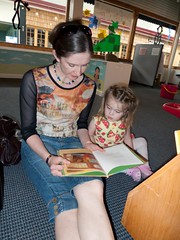
As Dora the Explorer celebrates 10 years on the air, the LA Times comments on her broader social significance. The children’s show features a young Latina heroine who travels through the jungle with her friends, speaking some Spanish, and solving simple math and word problems.
The idea was to foster pride among Latino children and familiarity with Latino culture among English speakers, but only indirectly as part of an entertainment show.
“It was just about creating a show we thought kids would love,” said Chris Gifford, who created the series along with Valerie Walsh Valdes and Eric Weiner. “We didn’t begin to think how long it might go for.”
Dora, however, has grown much larger than these seemingly modest origins:
Amid these warm-hearted adventures, Dora became a pop-culture superstar, a lucrative franchise and a force that helped shift the globalized juvenile television landscape that has become increasingly multicultural and bilingual. Dora, in some eyes, also became a poster child for immigration and the target of anti-immigrant sentiment.
The animated series is now broadcast in more than 100 countries — it’s the No. 1-rated preschool show in many of them, including France — and dubbed in 30 languages, such as Russian, Mandarin and German, with Dora mostly teaching English (in some cases Spanish).
“What’s been innovative about the show is it wasn’t conceptualized or presented as a Latino-themed show,” said Chon Noriega, director of UCLA’s Chicano Studies Research Center. “It was an educational series for kids that happened to have a Latino girl as the lead character. And it didn’t shy away from having a character that spoke Spanish. That allowed it to do something that was very unique.”
Dora has gone on to enjoy considerable success, culturally and economically (generating more than $11 billion in retail sales alone).
“Dora isn’t just a show; she’s DVDs, clothes, lunchboxes,” said Karen Sternheimer, an associate professor of sociology at USC and author of “It’s Not the Media: The Truth About Pop Culture’s Influence on Children.” “Nickelodeon has been very savvy about getting their characters into kids’ lives through a number of different platforms. They’ve taken branding to another level.”
The main character wasn’t originally going to be Latina, but:
The idea for an ethnic rebirth sprang after Johnson [a Nickelodeon exec responsible for the program] attended an industry conference during which the underrepresentation of Latinos in media was discussed.
The 2000 census showed that Latino communities were the nation’s fastest growing — and the biggest five-year Latino age group is infants to preschoolers. Yet data have long shown that Latinos are underrepresented in prime-time TV: UCLA research found that 4% of prime-time’s regular characters in 2004 were Latino, while Latinos make up about 15% of the U.S. population.
For years, the main source for children’s multicultural TV was PBS’ “Sesame Street.” …Dora’s “success really reflects a change in the media environment for children over the years,” Sternheimer said. “It’s a great reflection of the shifting multicultural nature of our society.”
Since “Dora,” the children’s TV landscape has embraced diversity. PBS Kids revamped “Dragon Tales” in 2005 to include Enrique, who is Colombian. “Jay Jay the Jet Plane” has added a bilingual plane named Lina. “Dora” also launched a spinoff, “Go Diego Go,” starring Dora’s 8-year-old cousin, in 2005.
Sociologists are among the experts who consult for the show:
Schoolteachers, sociologists and historians are all brought in to advise on “Dora” episodes. More than 20 cultural consultants have worked on the show to make Dora’s world reflect a pan-Latino culture that’s not just tortillas and mariachi music, Johnson said. “It was important for us that Dora represented the idea that being multicultural was super cool,” she said.
Cortés, who’s serves as a cultural consultant on the show, said not giving Dora a specific heritage made that idea a reality. “Not knowing where she was from allowed her to be a source of pride for anyone of Latino background,” he said. “She’s more relatable if you don’t peg her down.”
So, is it all a rosy animated multicultural picture? A sociologist, per usual, complicates the story:
“The show definitely homogenizes the many different origin groups that are comprised within the Latino ethnicity,” said Jody Vallejo, an assistant professor of sociology at USC. “So Latino children are getting a very broad view of who they are. At the same time, it does allow people from those different origins to make her their own character, to take ownership. For non-Latinos who watch the show, it makes Latinos more relatable. It demonstrates that bilingualism is not that bad. But it makes it seem like Latinos come from a monolithic culture.”






